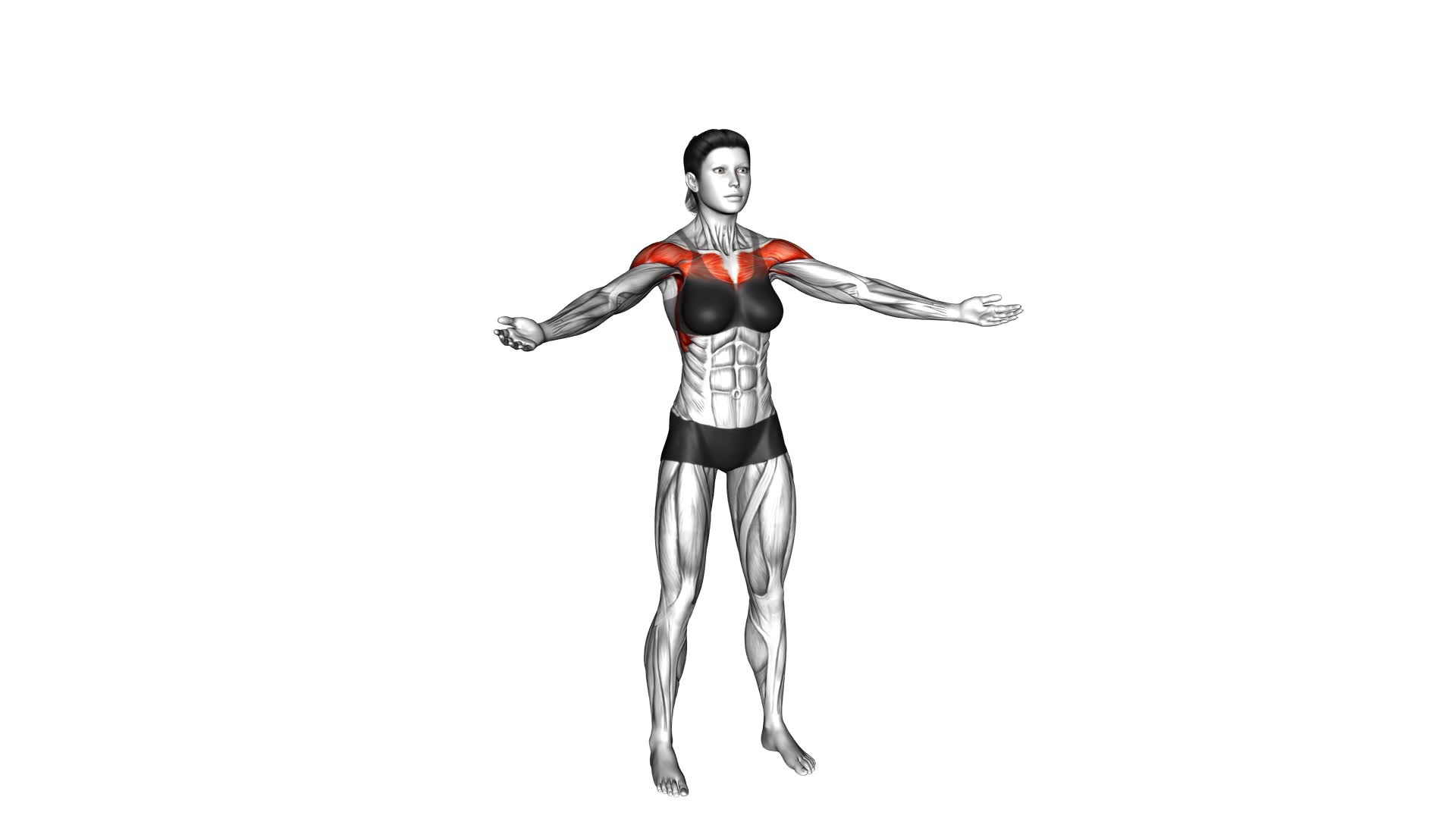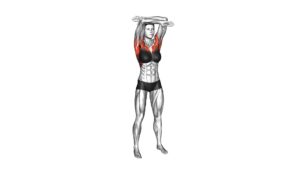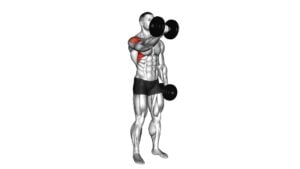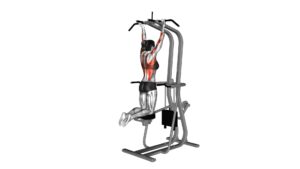Standing Underhand Crossover Raise (female) – Video Exercise Guide & Tips

Looking to tone your upper body? Try the Standing Underhand Crossover Raise. This exercise targets your shoulders, back, and arms, helping you achieve a strong and defined physique.
Watch This Exercise Video
In this article, we'll guide you through the proper form and technique, provide variations and modifications, and give tips to avoid common mistakes.
Get ready to boost your workout and watch your muscles transform. Let's get started!
Key Takeaways
- Targets deltoid muscles in shoulders
- Engages upper back muscles (rhomboids and trapezius)
- Strengthens and tones muscle groups
- Improves upper body strength
Benefits of Standing Underhand Crossover Raise
You will experience numerous benefits when incorporating the Standing Underhand Crossover Raise into your workout routine. This exercise primarily targets the deltoid muscles in your shoulders, specifically the anterior deltoids. In addition to the shoulders, it also engages your upper back muscles, including the rhomboids and trapezius. By performing this exercise, you can strengthen and tone these muscle groups, ultimately improving your upper body strength and posture.
To incorporate the Standing Underhand Crossover Raise into your workout routine, begin by standing with your feet hip-width apart and holding a dumbbell in each hand. Start with your arms extended in front of you, palms facing down. With a slight bend in your elbows, raise your arms out to the sides, forming a 'T' shape. As you lift your arms, cross them over each other, so your left hand is on top of your right hand. Lower your arms back to the starting position and repeat for the desired number of repetitions.
Now that you know the benefits and how to incorporate the Standing Underhand Crossover Raise into your routine, let's move on to discussing the proper form and technique for optimal results.
Proper Form and Technique
To ensure proper form and technique for the Standing Underhand Crossover Raise, it's essential to maintain a stable stance with your feet hip-width apart and dumbbells held in each hand. This exercise primarily targets the deltoids, which are the muscles responsible for shoulder movement. Additionally, it engages the trapezius muscles in the upper back, as well as the biceps in the arms.
When performing the Standing Underhand Crossover Raise, it's important to focus on your breathing. Inhale as you lower the dumbbells down to your sides, and exhale as you raise them up and across your body. This controlled breathing helps maintain stability and ensures that you're engaging the correct muscles throughout the exercise.
To execute the exercise with proper form, start by standing tall with your feet hip-width apart. Hold a dumbbell in each hand, palms facing towards your body. Keep your core engaged and your back straight throughout the movement. Begin by raising your arms out to the sides and slightly forward, crossing them over each other in front of your body at chest level. Pause briefly at the top, then lower the dumbbells back to the starting position in a controlled manner.
Variations and Modifications
For additional challenge and variety, you can incorporate different variations and modifications of the Standing Underhand Crossover Raise exercise. Here are some options to consider:
- Different grip options:
- Overhand Grip: Instead of using an underhand grip, try using an overhand grip. This will target your muscles in a slightly different way and provide a new challenge.
- Alternating Grip: Another option is to alternate your grip during each repetition. Start with an underhand grip on one side, then switch to an overhand grip on the other side. This will engage your muscles in a more balanced manner.
- Incorporating resistance bands:
- Resistance Band Variation: Attach a resistance band to a stable anchor point and hold the other end of the band in your hand. Perform the underhand crossover raise while maintaining tension in the band. This will add extra resistance and make the exercise more challenging.
- Band Assisted Variation: If you find the exercise too difficult, you can use a resistance band for assistance. Loop the band under your feet and hold onto the handles. This will provide support and help you perform the exercise with proper form.
By incorporating these variations and modifications, you can add excitement and challenge to your workout routine.
Now, let's move on to the next section about common mistakes to avoid.
Common Mistakes to Avoid
To ensure proper form and maximize the effectiveness of the Standing Underhand Crossover Raise, it's crucial to be mindful of common mistakes that may hinder your progress.
Proper alignment is key to performing this exercise correctly and avoiding injury. One common mistake to avoid is arching your back during the movement. This can put unnecessary strain on your lower back and take the focus away from your shoulders and upper back. Instead, engage your core and maintain a neutral spine throughout the exercise.
Another mistake to watch out for is lifting the weights too high. While it may be tempting to lift your arms as high as possible, doing so can compromise your form and lead to shoulder impingement. Instead, focus on lifting your arms to shoulder height, keeping them slightly bent to engage the muscles effectively.
It is also important to avoid using momentum to lift the weights. Swinging your arms or using a jerking motion can take away from the targeted muscles and increase the risk of injury. Instead, focus on controlled and deliberate movements, keeping your muscles engaged throughout the exercise.
Tips for Increasing Intensity and Progression
To increase the intensity and progress of the Standing Underhand Crossover Raise, focus on gradually increasing the weight or resistance used. This will help challenge your muscles and promote growth and strength development.
Here are a few ways to modify the exercise and incorporate weights into your workout:
- Increase the dumbbell weight: Start with a lighter weight that allows you to perform the exercise with proper form. As you become comfortable, gradually increase the weight to continue challenging your muscles.
- Use resistance bands: Instead of dumbbells, you can use resistance bands to add resistance to the exercise. This provides a different type of challenge and helps engage different muscle fibers.
- Vary the resistance band tension: Resistance bands come in different levels of resistance. Start with a lighter band and gradually progress to a higher resistance level to keep your muscles working hard.
Remember to always maintain proper form and technique while performing the Standing Underhand Crossover Raise. Incorporating weights and gradually increasing resistance will help you continue making progress and achieve your fitness goals.
Frequently Asked Questions
How Many Calories Does the Standing Underhand Crossover Raise Exercise Burn?
The standing underhand crossover raise exercise can be a great calorie burning workout. It targets your shoulders, arms, and upper back, giving you a total body workout.
However, if you're looking for alternative exercises that burn more calories, you can try high-intensity interval training (HIIT) workouts or cardio exercises like running or cycling. These activities engage multiple muscle groups and can help you burn more calories in a shorter amount of time.
Can Men Also Perform the Standing Underhand Crossover Raise Exercise?
Yes, men can also perform the standing underhand crossover raise exercise. It's a great exercise for men's fitness and can help improve shoulder and upper body strength.
However, if you're looking for alternative exercises, there are other options such as dumbbell lateral raises or bent-over lateral raises that can also target the same muscle groups.
Make sure to consult with a fitness professional to determine the best exercises for your specific goals and needs.
Is It Necessary to Use Dumbbells for the Standing Underhand Crossover Raise Exercise?
No, it isn't necessary to use dumbbells for the standing underhand crossover raise exercise. There are alternative equipment options available that you can use, such as resistance bands or cable machines.
To perform the exercise with proper form and technique, make sure to keep your back straight, engage your core muscles, and lift the weights in a controlled and controlled manner.
Focus on squeezing your shoulder blades together as you raise your arms.
Can the Standing Underhand Crossover Raise Exercise Help Improve Posture?
The standing underhand crossover raise exercise can definitely help improve your posture. By engaging your back muscles and strengthening your shoulders, this exercise promotes better alignment and stability.
In addition to posture benefits, this exercise is also great for overall fitness. You can vary the exercise by using different weights or incorporating variations to target specific muscle groups, such as your chest or upper back.
Incorporating this exercise into your routine will have multiple benefits for your overall fitness and posture.
How Many Repetitions and Sets Should Be Performed for the Standing Underhand Crossover Raise Exercise?
For the standing underhand crossover raise exercise, it's recommended to perform 8-12 repetitions per set. Aim for 2-3 sets, with a rest period of 30-60 seconds between sets.
This will help target your shoulder and upper back muscles effectively. To add variation, you can try different hand positions or use dumbbells for added resistance.
Remember to maintain proper form and control throughout the exercise.
Conclusion
In conclusion, the standing underhand crossover raise is a beneficial exercise for females looking to strengthen their upper body. By maintaining proper form and technique, and avoiding common mistakes, you can effectively target your shoulder and back muscles.
To increase intensity and progression, consider using variations and modifications, and always listen to your body. Incorporate this exercise into your routine for improved upper body strength and overall fitness.

Author
Years ago, the spark of my life’s passion ignited in my mind the moment I stepped into the local gym for the first time. The inaugural bead of perspiration, the initial endeavor, the very first surge of endorphins, and a sense of pride that washed over me post-workout marked the beginning of my deep-seated interest in strength sports, fitness, and sports nutrition. This very curiosity blossomed rapidly into a profound fascination, propelling me to earn a Master’s degree in Physical Education from the Academy of Physical Education in Krakow, followed by a Sports Manager diploma from the Jagiellonian University. My journey of growth led me to gain more specialized qualifications, such as being a certified personal trainer with a focus on sports dietetics, a lifeguard, and an instructor for wellness and corrective gymnastics. Theoretical knowledge paired seamlessly with practical experience, reinforcing my belief that the transformation of individuals under my guidance was also a reflection of my personal growth. This belief holds true even today. Each day, I strive to push the boundaries and explore new realms. These realms gently elevate me to greater heights. The unique combination of passion for my field and the continuous quest for growth fuels my drive to break new ground.







